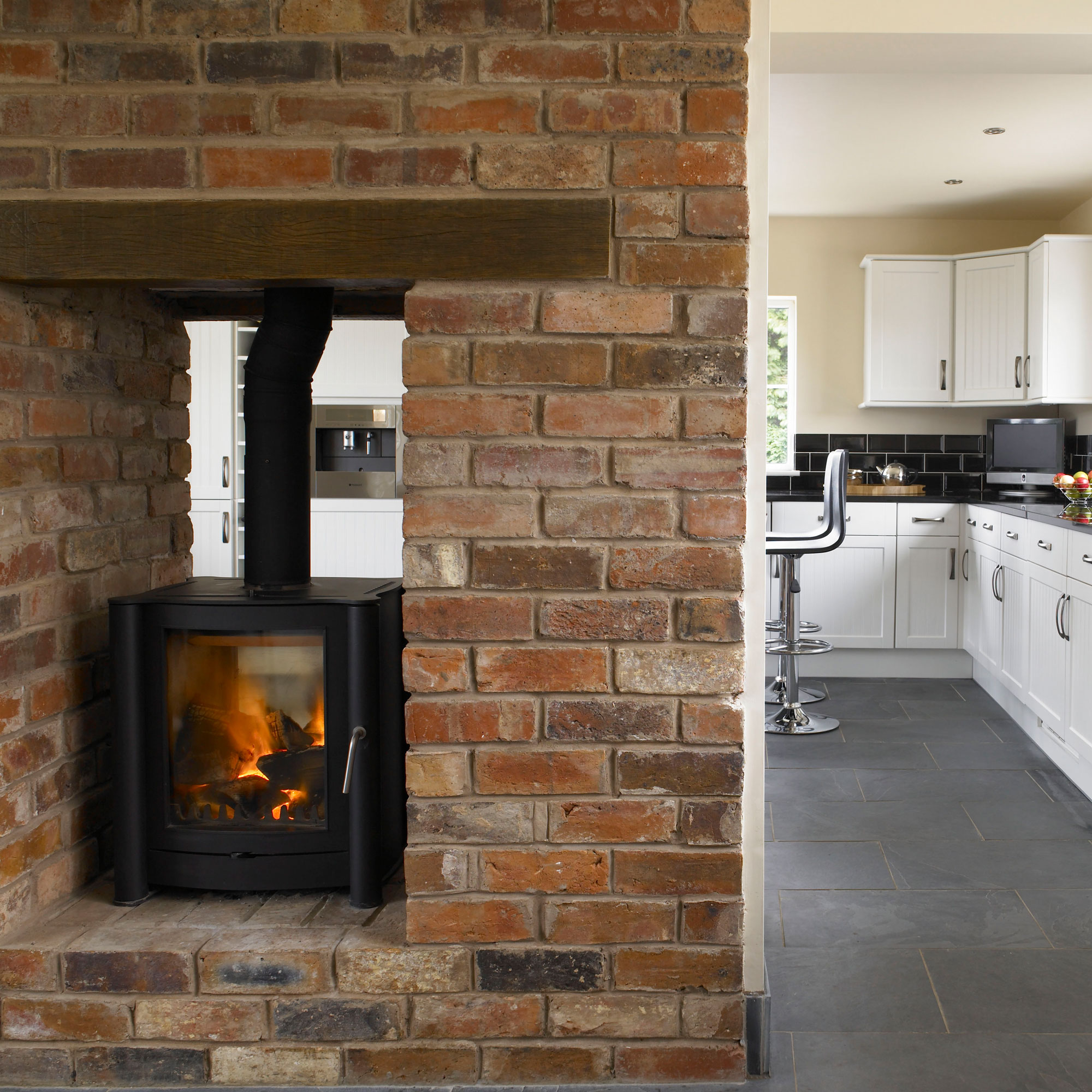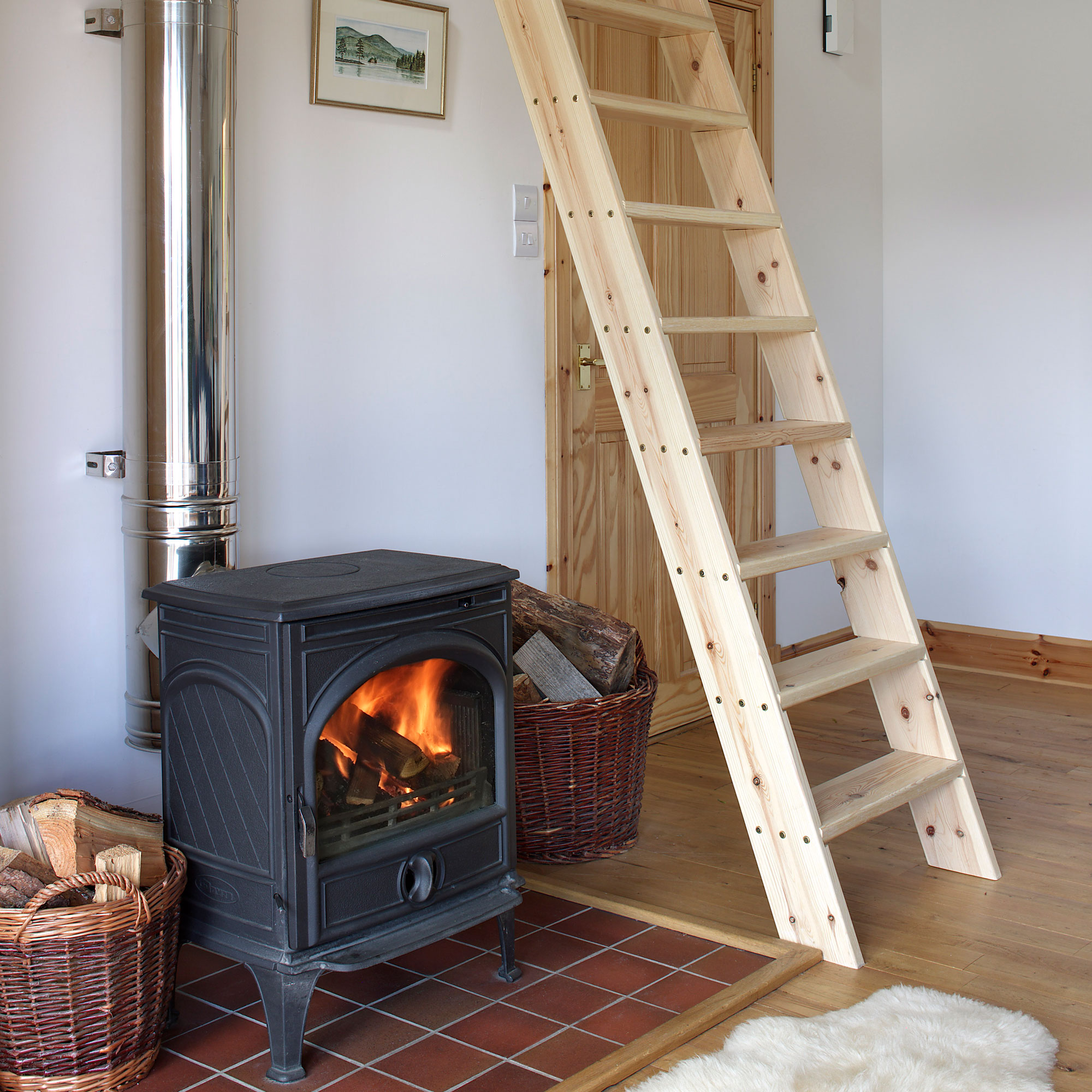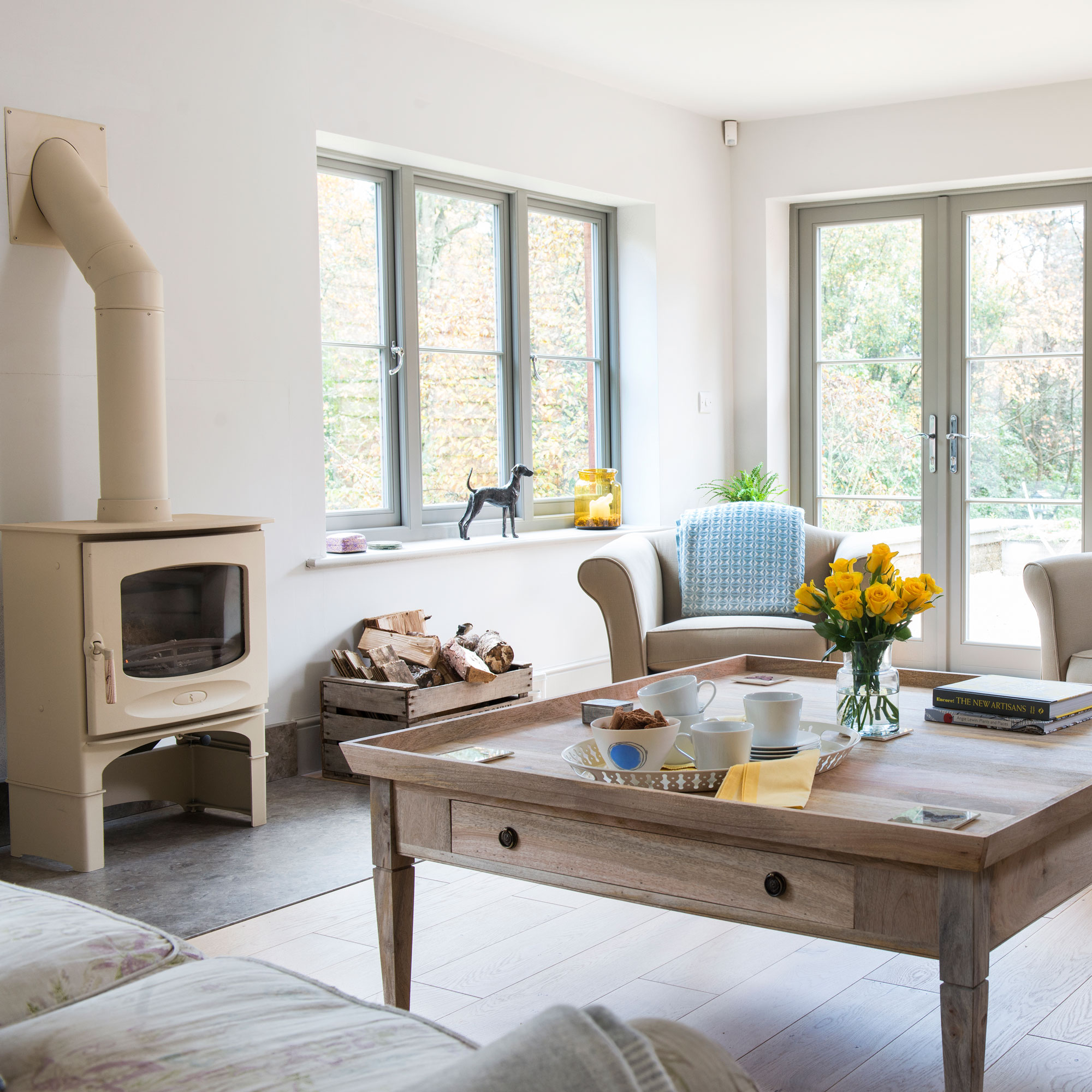A complete guide to wood-burning stoves – everything you need to know
What do you need to know about wood-burning stoves and log burners? Read our expert advice

Are you looking to replace an open fire with a more efficient way of heating your home? Or keen to add an additional form of heating during the winter months? Modern wood-burning stoves or log burners are more efficient and, therefore cheaper, to run than traditional gas and electric heaters. That's why they're so appealing with the current fuel crisis.
In addition to providing an efficient form of heating, wood burner ideas add character, style and a focal point. With its combination of heat and the visual impact of roaring flames, there’s nothing better when it’s cold outside, to snuggle up in front of a log burner.
‘An open fire is around 32 per cent efficient. A room open gas fire is approximately 55 per cent efficient. An Ecodesign wood-burning stove is typically around 80 per cent efficient,’ says Erica Malkin, communications manager at Stove Industry Alliance (SIA). Ecodesign is a standard which was implemented across Europe on 1 January 2022.
What are wood-burning stoves?

Put simply, they are self-contained heating appliances designed to produce heat inside your home through burning wood. A fire is contained in the body of the stove, which is usually made from steel or cast iron. The heat created radiates into the surrounding space. Any smoke from the fire leaves the chimney through the flue that leads to the chimney.
To help you make the right choice for your home, read the advice from a seasoned renovator on the things she wish she knew before installing a log burner at home.
What types of wood-burning stoves are there?

There's a variety of different types to choose from. These include:
Radiant stoves
These transmit heat through the glass door and the stove’s body to the air surrounding it. ‘The closer you are to a radiant stove the warmer it will feel, making them ideal for localised space heating,’ says Erica Malkin.
Sign up to our newsletter for style inspiration, real homes, project and garden advice and shopping know-how
Convection stoves
Designed with a secondary outer layer which clads the stove’s body, the cool air is drawn into the convection layer. It heats up as it rises within the stove and then flows into the room. ‘These stoves are well suited to larger rooms with high ceilings and where a high heat output is required,’ says Erica.
Multi-fuel stoves
Multi-fuel stoves offer the convenience of being able to burn both wood and smokeless fuels. While wood burns best on a bed of ash with air circulating above, solid fuels require air circulating below. To allow for both options, a multi-fuel stove has a raised grate. ‘Bear in mind that a multi-fuel stove might have a smaller window to accommodate the raised grate,’ says Erica.
Boiler stoves
A good option to help further reduce the carbon footprint of a home, boiler stoves generate hot water to power radiators. Some have the option to link to your existing gas or oil central heating system, thereby helping save energy at home, and reducing home heating bills.
Pellet stoves
These burn compressed wood or biomass pellets. Most feature a built-in hopper which is loaded with pellets and then operates autonomously for about 12 hours. This makes them very convenient to use.
What are the benefits of wood-burning stoves?

- Ideal for supplementary use when you need a sudden burst of heat during cold winter months. ‘Wood provides a more intense heat in a room compared to a radiator or underfloor heating and the heat can also be emitted for longer, says Jon Butterworth, director at Arada Stoves.
- Low emission and low carbon way to heat your home using renewable and sustainable fuel.
- Lower running cost ‘An efficient Ecodesign wood-burning stove costs about a third of the price of electric heating to run on average 10 per cent less than gas central heating for the average household,' says Erica Malkin.
- Mental health booster According to a recent study by British stove manufacturer Charnwood, 93 per cent of those surveyed recognise their stove’s positive impact on their wellbeing. Other manufacturers also promote this benefit. ‘The relaxation from the flickering flames can help reduce blood pressure, which is a huge benefit in today’s stressful world,’ says Vicky Naylor, general manager at ACR Stoves. Jon Butterworth agrees saying: ‘Lighting a fire encourages us to slow down and cosy up with friends and family on a cold evening.'
What are the negatives of wood-burning stoves?
The initial outlay to fit and install a wood burner can prove expensive – sometimes as much as the appliance itself. ‘However, many would argue that the fuel savings over time and the wellbeing benefits of using a wood-burning stove will outweigh the cost of installing one,’ says Cedric Wells at Charnwood.
Buying tips when purchasing wood-burning stoves

Here's what the experts advise:
1. Complete a site survey
Michael Coke, biomass product development manager at Stovax, recommends completing a site survey by a suitably qualified HETAS engineer before purchasing a new heating appliance. ‘The engineer will take into consideration the appropriate heat output for the room, the relevant location within the house, and the most suitable flue system for your appliance, to ensure it is suitable,’ he says.
2. Check for space
An engineer will be able to advise whether you have enough space for a wood burner, too. ‘You need to ensure that you have the right clearances around the stove to ensure you get the best operation,’ says Vicky Naylor. ‘If you squeeze a stove into an opening, the heat will be trapped there and could damage the surrounding area.’
3. Buy the correct size and heat output
You need to purchase a stove that is the correct size, with the right heat output in relation to the room it will be installed in. As mentioned above, a site survey will help with this. ‘As a guide, it is better to have a smaller stove that you can burn hard, rather than a large stove that produces too much warmth as you will end up opening doors and windows to disperse the heat,’ says Cedric Wells. Charnwood has a handy online stove calculator that will help you determine the best output for the size of your room.
4. Consider colour and style
A stove is quite a considerable investment and one that is likely to remain part of your living room ideas for many years, so attention to design is essential. ‘Think of your stove as a piece of furniture for heating. Choose a classic style that won’t date and consider a coloured one, which can look good all year round,’ says Cedric Wells.

5. Look for an efficient appliance
All stoves sold in the UK must now meet the criteria set for Ecodesign.
‘Essentially this ensures high efficiencies and low emissions, meaning they are 80-90 per cent better than older stoves or open fires,’ says Cedric Wells. ‘Look for the ‘ClearSkies certification when purchasing a stove to ensure it meets with the regulation,’ he says.
6. Make space for storing wood
It’s cheaper to buy wood in bulk and leave it to dry for up to two years unless you’re prepared to pay a higher fee for seasoned logs. This means you’ll need space for log storage ideas. If you don’t have room for an outdoor woodshed, you’ll need a dry, well-ventilated area which is protected from dampness and rain.
7. Get signed off by Building Control
If you are planning to install a wood-burning stove in your home, with either a new flue or an existing chimney, you will need to meet Building Regulations approval. This is even more important if you plan on installing your own log burner.
‘This can be done through a certified installer who is registered and will notify your local authority, or you can install the stove yourself, but you will need to gain approval from your local authority building control office,’ says Jon Butterworth.
‘Make an application online with your local council. Once this has been done, a building control officer will inspect the work and you’ll receive a completion certification. Make sure to keep this certificate when you come to sell your property.’
What maintenance is required for wood-burning stoves?

Also, when the stove isn’t being used regularly, such as in the summer months, Jon Butterworth recommends removing the throat plate in your stove and leaving the air inlets open. ‘It allows the air to flow through which will prevent rust build up.’
How long will wood-burning stoves last?
The average life of a log burning stove is 10 to 20 years. How long one lasts will depend on how often it is used and whether it is operated within the manufacturers’ guidelines. Bear in mind that, as technology evolves, so will an appliance’s efficiency.
‘If you currently own a stove manufactured 10 years ago or older, it will produce 80 per cent more emissions than an Ecodesign Ready stove produced today,’ says Jon Butterworth. So it is worth considering updating it with a more eco-friendly and more efficient model.
Why should you use seasoned wood?

Put simply, the drier the wood, the better it burns. A change in legislation in 2021 means any wood that you use needs to have a moisture content of less than 20 per cent.
‘The reason being is if anything higher is used it will lead to an increase of smoke and emissions with very little heat output and will cause soot to build up and the blackening of the stove glass,’ says Jon Butterworth.
As an example oak can take in excess of two years to fully season. If you’re buying your wood pre-cut, SIA recommends looking for the Woodsure Ready to Burn label. This shows the timber is ready for immediate use.
If you’re chopping your own wood, one way to know if it is seasoned or not, after having stored it for the recommended amount of time, is to look for radial cracks in the logs’ cross-section, loose bark and a dull colouring. The weight of seasoned wood is also noticeably lighter than wet wood.
What kinds of real wood can you burn in a wood-burning stove?
Specialist firewood producer Certainly Wood, recommended by SIA, offers a useful guide on the different wood types ideal for use in wood-burning stoves:
Oak has a long burn and good heat output. At times, a little more draft/air from the stove setting is required to maintain a good burn, but once a good base is established, the burn time will be long.
Ash provides a bright flame and burns very nicely, albeit slightly faster than oak.
Beech burns with a nice bright yellow flame and for a long time. It also has a smooth bark so is easy to handle.
Birch is one of the most attractive of logs due to its silvery, flaky bark. It burns with a bright flame, but will burn quite quickly. Typically 100 per cent birch will be from Eastern Europe and not British, so you need to consider the carbon footprint of delivery.
Softwoods such as spruce, larch, pine and Douglas fir can all be used in a log burner but, as they are less dense than hardwoods described above, you will need twice as many logs to achieve the same heat output.
What are the alternative fuel sources for a log burner?

You should always refer to the manufacturer’s instructions when selecting the correct fuel for your stove as it is very different to choosing a fuel for your fireplace ideas. ‘Using the wrong fuel may invalidate the warranty,’ says Erica Malkin. However, as a guide, here are the most common options:
Wood/sawdust briquettes These are made by compressing together hardwood, softwood, or a mixture of the two. ‘Look for those made from 100 per cent wood to ensure that you avoid any that contain contaminants such as paint or glue,’ says Erica. What’s more, once the wood briquettes are placed in the stove, don’t touch them. ‘Let them break down themselves as you don’t want to mess with the structure of the briquette,’ says Declan Kingsley-Walsh, managing director at Morso.
Coffee logs These are sustainably made from recycled coffee grounds and can burn 20 per cent higher than kiln-dried wood logs.
Coal This can be used in a multi-fuel stove, but it needs to be a smokeless coal, such as Anthracite. This fuel has a high carbon content and few impurities, which means it burns far cleaner than softer, dirtier coals and produces less smoke and pollutants when burnt.
Wood pellet Used for pellet stoves, these are made of compressed sawdust or wood dust. Sometimes this is a waste product from other industries such as sawmills. The pellets are held together by the natural lignin in the wood, so no glue is needed.

Sophie Vening is a freelance journalist and editor with more than 16 years’ experience writing about homes and properties. She’s worked for some of the UK’s leading interiors, self-build and property titles including, Grand Designs, Ideal Home, House Beautiful, Build It, The Metro Homes & Property and The Evening Standard Homes & Property.
She enjoys writing about complex issues in an easy-to-understand way.